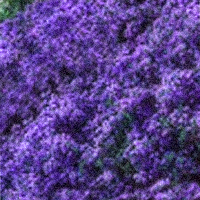The Background Landscape: Gardening with California Natives in Los Angeles
Margo Bistis

On my way to CalArts to teach a class on art history, I pass the exit for La Tuna Canyon Road on the 210 freeway. It is an exit I've taken many times since my discovery of native California plants in the mid-1990s. Nestled in the canyon lies the Theodore Payne foundation, dedicated to promoting "the understanding and preservation of California native flora." I wish I had time for a quick stop. But I never seem to have extra time these days, so I drive on, thinking about all the things that need doing in the garden, the holes that need filling, the dilemma of the weed-infested native lawn that doesn't like foot traffic.
For the eco-conscious gardener living in Los Angeles, California natives are a commitment. These "low-maintenance" plants transform the garden into a puzzle. One is constantly trying to figure out what will grow where, what plant to take a chance on, when to move a struggling native to a different location. The number of fatalities is high, and costly to those pursuing this particular garden fantasy.
It is also a fantasy that clashes with the manicured lawns and landscapes of many Angeleno homes. Adjacent to my scrubby Ceanothus Ray Hartman, with its small blue flowers during spring, are two regal Plumerias from Hawaii covered with pink and yellow lotus-like flowers from spring through fall, and up the street, a Mexican Garden of Eden from which only the monkeys are missing. The comparison highlights the humble quality of California natives. With the exception of the wildflower season and the brilliant hue of poppies, the native garden is a background landscape, a muted statement about place and presence in Los Angeles.
This "low-key" style of gardening is practiced by eco-conscious gardeners who are also nature preservationists. "Save our natural heritage," is the motto of native plant nurseries and botanical gardens. Devotees of this flora remind me of Charles Lummis and the whole Arts-and-Crafts obsession with anything and everything indigenous. Are we not a new-fangled version of the turn-of-the-century craft modernist, restoring and stylizing the fragile flora of California to its rightful place? Are we not essentially rustic primitivists desperately trying to respond to the environmental crisis of southern California while our unenlightened neighbors blissfully douse their lawns on Mondays and Thursdays?
The parallel to early modernism is made more eerie by the behavior of the native plants themselves. With the exception of a few species like the Matilija poppy and the Anacapa morning glory, both aggressive spreaders who rapidly become pests, most native plants are dignified growers. By that I mean, they grow with restraint, thus require little pruning, and like in all delicate eco-systems, they balance out each others' nutrient needs. One might thus describe California native plants as the botanical equivalent of Rousseau's "noble savage." They contain all the sympathetic qualities that the eighteenth-century French philosopher invested in the Western myth of "an individual living in a ‘pure state of nature'—gentle, wise, uncorrupted by the vices of civilization." And they appeal to Angelenos like myself seeking to salvage this myth for the twenty-first century. Liberal politics merges with aesthetics, and we feel better.
Until the next time we pay the bill at Theodore Payne, or at the bi-annual plant sale at Rancho Santa Ana Botanical Garden, where even a modest shopping list can exceed $100.00. My latest purchase: Salvia Desperado, one of a growing list of cultivars (hybrids) developed by breeders to "improve" on California's natural heritage. The ad for this plant on the website of Yerba Buena Nursery reads as follows: "A cross between the White and Cleveland Sages, this plant combines the best attributes of both! A vigorous grower to 6 feet high and wide, broad pale gray foliage is topped with wands of lavender flowers. Aromatic, very drought tolerant, and attractive to bees and hummingbirds, as well as providing nutritious seed for quail and other songbirds." The humble "pure" native species has a new competitor. Not the rapacious, soil-depleting barbarians from other countries and continents like ice plants, bougainvillea, and eucalyptus, but the cultivar, promising greater vigor, more showy blooms, and better "stability" in degraded soils. The cost of replacing fragile California natives is only part of the reason for the attraction of cultivars. There is such a thing as too much background.
Growing water shortages in Los Angeles and the global environmental crisis may help make the "native" California garden palatable to more Angelenos in the future. For the time being, those committed to the background landscape would be wise to keep evolving it. With the end of American exceptionalism, the task of background living is upon us, and may prove even more challenging than winning the frontier.